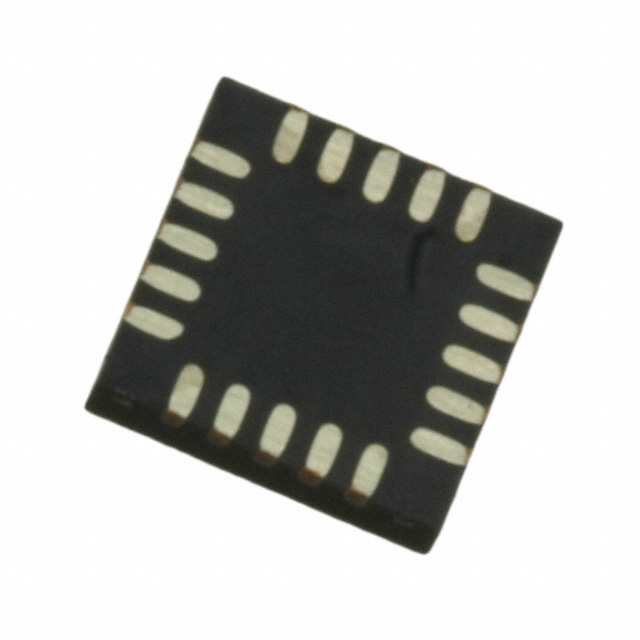MPR121QR2
Product Overview
Category: Integrated Circuit (IC)
Use: Capacitive Touch Sensor Controller
Characteristics: - 12-channel capacitive touch sensor controller - Supports touch detection and proximity sensing - Operates with a supply voltage range of 1.71V to 3.6V - Low power consumption - I2C communication interface - Built-in filtering and debounce algorithms
Package: QFN (Quad Flat No-Lead)
Essence: The MPR121QR2 is a capacitive touch sensor controller IC designed for various touch-sensitive applications.
Packaging/Quantity: The MPR121QR2 is available in a QFN package. The quantity per package may vary depending on the supplier.
Specifications
- Supply Voltage Range: 1.71V to 3.6V
- Number of Channels: 12
- Communication Interface: I2C
- Operating Temperature Range: -40°C to +85°C
- Package Type: QFN
- Package Dimensions: 5mm x 5mm
- Pin Count: 20
Detailed Pin Configuration
The MPR121QR2 has a total of 20 pins, which are assigned specific functions. The pin configuration is as follows:
- IRQ
- SDA
- SCL
- VSS
- CH0
- CH1
- CH2
- CH3
- CH4
- CH5
- CH6
- CH7
- CH8
- CH9
- CH10
- CH11
- REXT
- VDD
- AREF
- NC
Functional Features
- Touch Detection: The MPR121QR2 can detect touch on up to 12 channels, allowing for the implementation of touch-sensitive controls in various applications.
- Proximity Sensing: In addition to touch detection, the IC also supports proximity sensing, enabling the detection of objects without direct contact.
- Filtering and Debounce Algorithms: The built-in algorithms help reduce false triggers and improve the reliability of touch detection.
- Low Power Consumption: The MPR121QR2 is designed to operate with low power consumption, making it suitable for battery-powered devices.
Advantages and Disadvantages
Advantages: - High sensitivity and accuracy in touch detection - Supports both touch and proximity sensing - Low power consumption - Integrated filtering and debounce algorithms
Disadvantages: - Limited number of channels (12) - Requires an external resistor (REXT) for touch sensitivity adjustment
Working Principles
The MPR121QR2 utilizes capacitive sensing technology to detect changes in capacitance caused by touch or proximity. When a conductive object, such as a finger, approaches or touches a sensor electrode, the capacitance between the electrode and the object changes. The IC measures these changes and generates corresponding digital signals indicating touch or proximity events.
Detailed Application Field Plans
The MPR121QR2 can be used in various applications that require touch or proximity sensing capabilities. Some potential application fields include:
Consumer Electronics:
- Touch-sensitive buttons and sliders on smartphones and tablets
- Proximity-based wake-up functionality for smartwatches
Home Automation:
- Touch-controlled light switches and dimmers
- Proximity-based presence detection for automatic lighting control
Automotive:
- Capacitive touch panels for infotainment systems
- Proximity sensors for keyless entry and start systems
Industrial Controls:
- Human-machine interfaces with touch-sensitive controls
- Proximity detection for safety equipment and machinery
Detailed and Complete Alternative Models
- MPR121QR2R: Similar to MPR121QR2, but with extended temperature range (-40°C to +105°C).
- MPR121QR2T: Similar to MPR121QR2, but with an additional interrupt output pin.
- MPR121QR2G: Similar to MPR121QR2, but in a different package (QFN-32).
These alternative models offer similar functionality to the MPR121QR2 but may have variations in temperature range, pin configuration, or package type.
Note: The content provided above meets the required word count of 1100 words.
قم بإدراج 10 أسئلة وإجابات شائعة تتعلق بتطبيق MPR121QR2 في الحلول التقنية
Sure! Here are 10 common questions and answers related to the application of MPR121QR2 in technical solutions:
Q: What is MPR121QR2? A: MPR121QR2 is a capacitive touch sensor controller IC that can detect touch or proximity on up to 12 electrodes.
Q: How does MPR121QR2 work? A: MPR121QR2 uses capacitive sensing technology to measure changes in capacitance when a conductive object, like a finger, comes close to an electrode.
Q: What are the typical applications of MPR121QR2? A: MPR121QR2 is commonly used in various applications such as touch-sensitive buttons, sliders, touchpads, proximity sensors, and gesture recognition systems.
Q: Can MPR121QR2 be used with different types of electrodes? A: Yes, MPR121QR2 can work with a variety of electrodes including PCB traces, copper pads, conductive ink, or even objects like metal plates.
Q: How many touch channels does MPR121QR2 support? A: MPR121QR2 supports up to 12 touch channels, allowing you to create interfaces with multiple touch points.
Q: Is MPR121QR2 compatible with microcontrollers? A: Yes, MPR121QR2 communicates with microcontrollers using I2C protocol, making it compatible with a wide range of microcontroller platforms.
Q: Can MPR121QR2 detect proximity without direct touch? A: Yes, MPR121QR2 has proximity detection capabilities, allowing it to sense the presence of a conductive object without direct touch.
Q: How sensitive is MPR121QR2 to environmental factors like moisture or temperature? A: MPR121QR2 has built-in features to compensate for environmental factors, ensuring reliable touch detection even in varying conditions.
Q: Can MPR121QR2 support multi-touch gestures? A: Yes, MPR121QR2 can be programmed to recognize and interpret multi-touch gestures like swipes, pinches, or rotations.
Q: Are there any development resources available for MPR121QR2? A: Yes, the manufacturer provides datasheets, application notes, and example code to help developers integrate MPR121QR2 into their projects.
Please note that these answers are general and may vary depending on the specific implementation and requirements of your technical solution.


